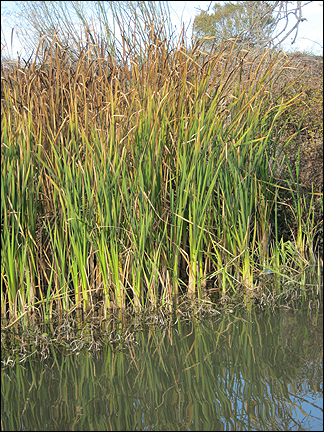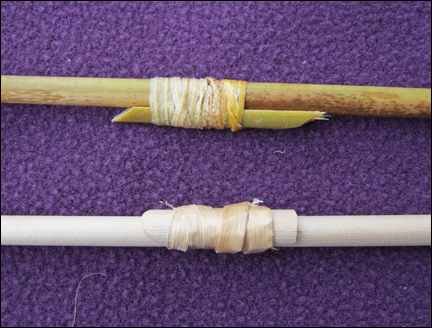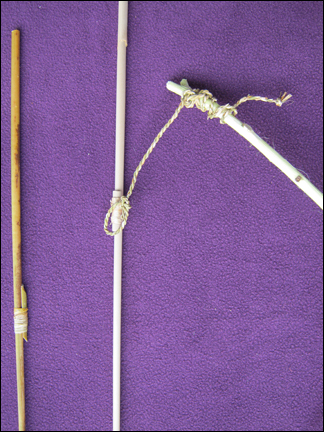
How many practical uses for cattails (Typha sp.) are there? I’ll bet that an entire issue of the Bulletin of Primitive Technology could be devoted to that most useful of plants, but here‘s one that’s strictly for fun. The cattail whip dart is a logical extension of the "Shingle Dart" described in the Appendix. It can, however, be made from all "natural" materials: a cattail bloom spike, a flattened cattail leaf and bindings made from more cattail leaf to hold it all together. This is another good children’s project because they can do most of the work themselves and it weighs so little that there is practically no hazard involved. Of course, some embryo rocket scientist could always use the same technique to make a much heavier "traveling arrow" as mentioned in the "Shingle Dart" article and get into some real mischief.
The Steps:
1. Cut a cattail bloom spike, maybe 2 feet (60 cm) long. Length is not very critical.
2. Use heat to straighten it, if necessary.
3. Split the top (thinner) end for 4 inches (10 cm). This is where the cattail leaf vane will be placed to guide it.
4. Create the vane by folding a previously flattened and soaked cattail leaf to put in the split.
5. Tie the stabilizing vane in place using a piece of cattail leaf or other natural fiber. For permanence. you could add glue before binding. Warning: If you start with a blooms pike that is not entirely dry, it will shrink as it dries and the bindings will loosen.
6. Add the hook that will engage the loop of string. It can be cut from another piece of the cattail bloom spike. It should be tied on slightly forward of the balance point. Tie it on with cattail leaf fiber or other natural fiber. A little glue always helps.
7. Make the whip out of a flexible stick around 2 feet (60 cm) long with a piece of string attached to the skinny end. Tie a loop on the end of the string. Try a piece of string made from finely shredded cattail leaf fiber.
You’re ready to throw, either underhand or overhand! A moderate underhand throw straight up will make the dart go almost out of sight.

Cattails growing (late in the season - December)

From top to bottom: an intact bloom spike, three with top removed, one with split and three with vane tied into split.

Closeup of the spur that engages the string loop.

Closeup of the vane that is tied in the split.

Giving it an underhand toss.

The loop in the string engaging the spur on the side of the dart.
Appendix: The Shingle Dart
My introduction to the shingle dart came from my Dad when I was eight-years-old. He acquired an old cedar shingle, whittled it into the shape of a weather vane and cut a notch exactly at the balance point. Then he cut a willow switch about two feet (60 cm) long, tied a foot (30 cm) of string on the end of the switch and put a loop in the end of the string. I spent untold hours using the switch and string to fling the dart very high into the air. I think this was a popular pastime of the late nineteenth century for young boys. It is described in D.C. Beard's "The American Boys Handy Book," first published in 1882, as a "Whip-Bow." Many years ago, I read in a book on the Indians of the Great Plains, an account of the "traveling arrow" which was almost exactly the same. It was used to lob arrows into a pond full of ducks. I also saw the late George Stewart demonstrate a similar weapon at the Rabbitstick Rendezvous several years ago. This makes a great project for children, who are just learning how to use a knife.
The ones I have made recently have been made from cedar shingles. The length is 17 inches (43 cm), the front end is 5/8 inch (1.8 cm) wide and the tail is 1 1/2 inches (4 cm) wide. The notch for attaching the string loop is placed at the balance point. I hope it is obvious that the thick end of the shingle is in front and the tail is the made from the thin end. The whip used to propel the shingle dart can be anywhere from one foot (30 cm) to three feet (90 cm) long, depending on the age and size of the thrower. They can be thrown either underhand or overhand.
E-mail your comments to "Richard A. Baugh" at richardbaugh@att.net
We hope the information on the PrimitiveWays website is both instructional and enjoyable. Understand that no warranty or guarantee is included. We expect adults to act responsibly and children to be supervised by a responsible adult. If you use the information on this site to create your own projects or if you try techniques described on PrimitiveWays, behave in accordance with applicable laws, and think about the sustainability of natural resources. Using tools or techniques described on PrimitiveWays can be dangerous with exposure to heavy, sharp or pointed objects, fire, stone tools and hazards present in outdoor settings. Without proper care and caution, or if done incorrectly, there is a risk of property damage, personal injury or even death. So, be advised: Anyone using any information provided on the PrimitiveWays website assumes responsibility for using proper care and caution to protect property, the life, health and safety of himself or herself and all others. He or she expressly assumes all risk of harm or damage to all persons or property proximately caused by the use of this information.
© PrimitiveWays 2013